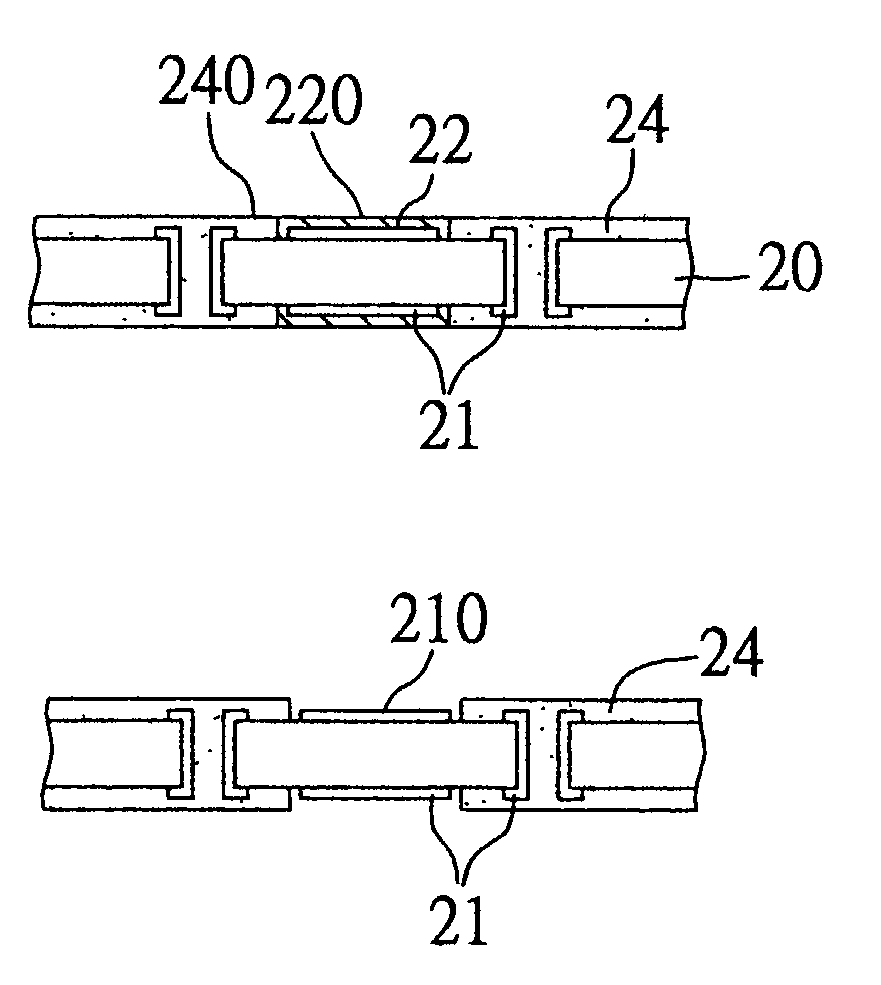Fabrication method of circuit board
a technology of circuit boards and fabrication methods, applied in resist details, non-metallic protective coating applications, conductive pattern formation, etc., can solve the problems of increasing process complexity in fabrication, simplify the fabrication process, and effectively simplify the fabrication process of circuit boards.
- Summary
- Abstract
- Description
- Claims
- Application Information
AI Technical Summary
Benefits of technology
Problems solved by technology
Method used
Image
Examples
first preferred embodiment
[0025]FIGS. 1A to 1C illustrate process steps involved in a fabrication method for a circuit board 2 of the first embodiment of the invention.
[0026]Referring to FIG. 1A, the first step is to prepare a core layer 20, with predetermined circuitry of conductive traces 21 being formed on two opposing surfaces of the core layer 20. The conductive traces 21 are defined with a plurality of terminals 210 that serve as bond pads or bond fingers where solder balls, solder bumps or bonding wires (not shown) are bonded for electrical connection purpose. And, an insulating material 22 such as photo resist is applied on each of the terminals 210 of the conductive traces 21.
[0027]The core layer 20 can be made of a resin material, such as epoxy resin, polyimide resin, FR4 resin, etc. And, a plurality of vias 23 are formed to penetrate through the core layer 20. In fabrication, a copper film is respectively attached to each surface of the core layer 20, and patterned to define the conductive traces ...
second preferred embodiment
[0033]FIGS. 2A to 2C illustrate the second embodiment of the fabrication method for a circuit board 2 of the invention. This embodiment is similar to the previous first embodiment; thus, components or parts in this embodiment are designated by the same reference numerals as those in the first embodiment.
[0034]Referring first to FIG. 2A, a core layer 20 formed with conductive traces 21 is prepared, each of the conductive traces 21 being defined with a terminal 210. And, an insulating material 22 e.g. photo resist is applied on the terminal 210 of each of the conductive traces 21 in a manner as to entirely cover the terminal 210.
[0035]Referring to FIG. 2B, a non-solderable material 24 is applied over the core layer 20 in a manner as to hermetically cover the conductive traces 21 formed on the core layer 20, with the insulating material 22 being exposed to outside of the non-solderable material 24. And, the non-solderable material 24 is adapted to be surface-flush with the insulating m...
PUM
| Property | Measurement | Unit |
|---|---|---|
| Electrical conductor | aaaaa | aaaaa |
| Coefficient of linear thermal expansion | aaaaa | aaaaa |
| aaaaa | aaaaa |
Abstract
Description
Claims
Application Information
 Login to View More
Login to View More - R&D
- Intellectual Property
- Life Sciences
- Materials
- Tech Scout
- Unparalleled Data Quality
- Higher Quality Content
- 60% Fewer Hallucinations
Browse by: Latest US Patents, China's latest patents, Technical Efficacy Thesaurus, Application Domain, Technology Topic, Popular Technical Reports.
© 2025 PatSnap. All rights reserved.Legal|Privacy policy|Modern Slavery Act Transparency Statement|Sitemap|About US| Contact US: help@patsnap.com



